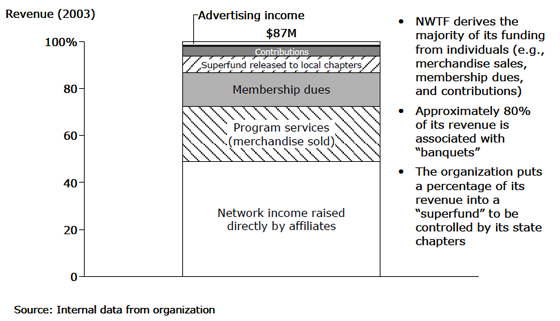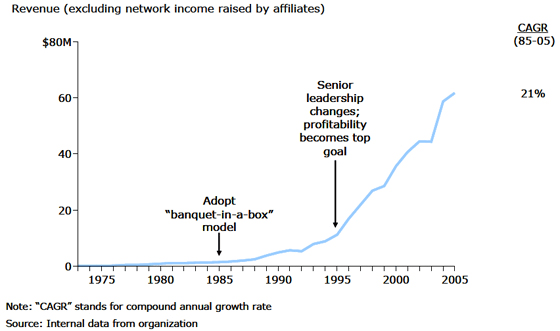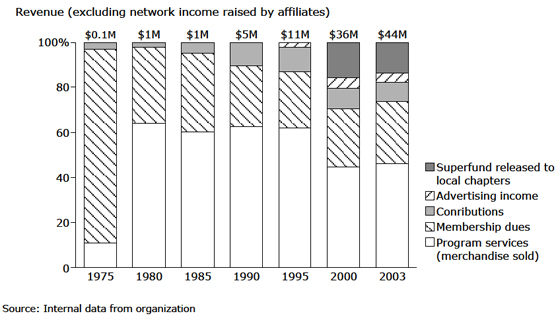You don't get a bit of money for conservation from someone chaining themselves to a tree. Hunting is conservation.
– James Sparks, Chief Financial Officer
Overview
Related Content
How Nonprofits Get Really BigOrganization Profiles from How Nonprofits Get Really Big
The National Wild Turkey Federation is a grassroots nonprofit organization that supports scientific wildlife management on public, private, and corporate lands to promote wild turkey hunting as a traditional North American sport. The organization began in 1973 as an intermediary between the wildlife agencies of neighboring states seeking to repopulate areas where wild turkeys had vanished. It now has 500,000 members as well as 2,000 local chapters that pursue conservation projects at the state and local level. Its national office focuses on national conservation efforts, biological research, and advocacy to increase hunting opportunities and safety.
NWTF derives the majority of its revenues from a “banquet-in-a-box” model, whereby regional fundraising directors ask local turkey enthusiasts to run fundraisers for new and existing members. Its national headquarters supplies merchandise for sale (e.g., shotguns, hats, and other hunting gear) and raffle prizes. NWTF runs well over 2,000 banquets per year, averaging $10,000 each in net receipts.
Since its founding, the wild turkey population in the U.S. has grown from 1.3 to 7.0 million, thanks in large part to NWTF. Now the organization is expanding its scope to attract new groups to wild turkey hunting, including women, youth, and people with disabilities.
Founding date: 1973
Revenue (2003): $87 million
Structure: Network
NCCS classification: Environment
Services: Protects and expands wild turkey habitat; promotes wild turkey hunting and outdoor activities, especially for women, youth, and people with disabilities
Beneficiaries: Hunters; the public at large
Leadership (selected): Bill Torhorst, President; Rob Keck, Chief Executive Officer; Carl Brown, Chief Operating Officer; James Sparks, Chief Financial Officer
Address: 770 Augusta Road, Edgefield, SC 29824
Website: www.nwtf.org

Growth Story
- 1973 – NWTF is founded as a mechanism to facilitate the movement of wild turkeys between state wildlife agencies.
- 1970s - 1980s – NWTF grows slowly, reaching a peak of 20,000 members.
- 1985 – Looking for new funding streams, NWTF’s leadership team decides to adopt a “banquet-in-a-box” program to help local members run fundraisers.
- 1996 – NWTF undergoes a shift in senior management and governance structure, resulting in a fundamental cultural shift to run more like a professionally managed business. Profitability (defined as having sufficient funds available to reinvest in employees and other assets that help NTWF achieve its mission) becomes the #1 goal.
- 1995 - 2005 – The “banquet-in-a-box” program grows from 500 banquets in 1995 to over 2,000 banquets in 2005. Cost-cutting and aggressive merchandising generate substantial financial gains.
Revenue Trends
Revenue growth: NWTF grew rapidly through the late 1990's once management honed the "banquet-in-a-box" style of fundraising and focused on running a professionally managed organization.

Funding mix: While revenues have diversified over time, the root source of NWTF’s funding remains individual turkey hunters.

Actions That Helped Propel Growth in Funding
- Focused on “profitability” and organizational execution. Profitability became the #1 goal for NWTF in 1995. Regional fundraising directors have explicit targets. Management has focused on operational efficiencies to cut the merchandise costs for the “banquet-in-a-box” special events, building its own procurement, warehouse, and distribution capabilities. NWTF has ploughed the savings back into operating reserves, professional development, and other capacity-building and mission-related activities.
- Stuck to its mission. While other hunting/conservation groups have tended to move closer to the environmentalist side over time, NWTF has reinforced its alignment with hunters.
- Aligned its fundraising and program models. NTWF had only 20,000 members in its early days. Following the adoption of the “banquet-in-a-box” model, NWTF grew rapidly to its current size of 500,000 members. Growth in wild turkey populations, the popularity of hunting, membership, and revenue are all related. Larger turkey populations support more hunters who are in turn willing to join NWTF to conserve more wild turkey habitat for hunting.
- Reinforced local ties. Because wild turkeys inhabit all 50 states and do not migrate, NWTF’s mission is directly relevant and highly visible at the local level. Reinforcing these local ties, NWTF allocates a percentage of its revenue to a “superfund” for state-level initiatives controlled by local groups.
Funding Challenges
- Clarifying decision-making authority. NTFW’s board formerly held the sole ability to dismiss management team members. The result was unclear decision-making authority and an inability for the CEO to act. NTWF consolidated authority under the CEO in 1996, enabling NWTF to establish a clear sense of direction.
- Managing an environment with distributed power. NTWF’s model requires major allocations of money and decision-making authority to the local level, making it more challenging for headquarters to steer the organization.

